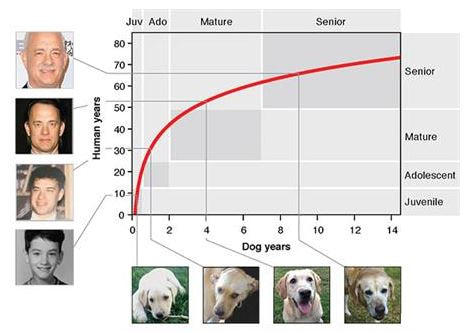
If you have a cross breed, in addition to seeing how old your dog is in human years, why don't you find out what the breed crosses that make up your dog are as well? In addition to satisfying your curiosity (important!), knowing what breeds are involved will also give you additional information, such as why your dog does the things it does, insight to common genetic diseases and to look out for them, possible behaviour concerns, to mention a few. Doing a DNA test is as simple as the ABC, and no need for any vet visits either. Visit us at www.muttmix.co.za for more details - We also have an allergy test available for any owners that want to know what is causing their dogs allergies/intolerance's. Very simply to do, non invasive, and done in the comfort of your own home.
How Old Is Your Dog in Human Years? Scientists Develop Better Method than ‘Multiply by 7’
By mapping molecular changes in the genome over time, UC San Diego researchers developed a formula to more accurately compare dog age to human age — a tool that could also help them evaluate how well anti-aging products work
By mapping molecular changes in the genome over time, UC San Diego researchers developed a formula to more accurately compare dog age to human age — a tool that could also help them evaluate how well anti-aging products work
If there’s one myth that has persisted through the years without much evidence, it’s this: multiply your dog’s age by seven to calculate how old they are in “human years.” In other words, the old adage says, a four-year-old dog is similar in physiological age to a 28-year-old person.
But a new study by researchers at University of California San Diego School of Medicine throws that out the window. Instead, they created a formula that more accurately compares the ages of humans and dogs. The formula is based on the changing patterns of methyl groups in dog and human genomes — how many of these chemical tags and where they’re located — as they age. Since the two species don’t age at the same rate over their lifespans, it turns out it’s not a perfectly linear comparison, as the 1:7 years rule-of-thumb would suggest.
But a new study by researchers at University of California San Diego School of Medicine throws that out the window. Instead, they created a formula that more accurately compares the ages of humans and dogs. The formula is based on the changing patterns of methyl groups in dog and human genomes — how many of these chemical tags and where they’re located — as they age. Since the two species don’t age at the same rate over their lifespans, it turns out it’s not a perfectly linear comparison, as the 1:7 years rule-of-thumb would suggest.
The new methylation-based formula, published July 2 in Cell Systems , is the first that is transferrable across species. More than just a parlor trick, the researchers say it may provide a useful tool for veterinarians, and for evaluating anti-aging interventions.
“There are a lot of anti-aging products out there these days — with wildly varying degrees of scientific support,” said senior author Trey Ideker, PhD, professor at UC San Diego School of Medicine and Moores Cancer Center. “But how do you know if a product will truly extend your life without waiting 40 years or so? What if you could instead measure your age-associated methylation patterns before, during and after the intervention to see if it’s doing anything?” Ideker led the study with first author Tina Wang, PhD, who was a graduate student in Ideker’s lab at the time.
The formula provides a new “epigenetic clock,” a method for determining the age of a cell, tissue or organism based on a readout of its epigenetics — chemical modifications like methylation, which influence which genes are “off” or “on” without altering the inherited genetic sequence itself.
Epigenetic changes provide scientists with clues to a genome’s age, Ideker said — much like wrinkles on a person’s face provide clues to their age.
Ideker and others have previously published epigenetic clocks for humans, but they are limited in that they may only be accurate for the specific individuals on whom the formulas were developed. They don’t translate to other species, perhaps not even to other people.
Ideker said it was Wang who first brought the dog idea to him.
“We always look at humans, but humans are kind of boring,” he said. “So she convinced me we should study dog aging in a comparative way.”
To do that, Ideker and Wang collaborated with dog genetics experts Danika Bannasch, DVM, PhD, professor of population health and reproduction at UC Davis School of Veterinary Medicine, and Elaine Ostrander, PhD, chief of the Cancer Genetics and Comparative Genomics Branch at the National Human Genome Research Institute, part of the National Institutes of Health. Bannasch provided blood samples from 105 Labrador retrievers. As the first to sequence the dog genome, Ostrander provided valuable input on analyzing it.
Dogs are an interesting animal to study, Ideker said. Given how closely they live with us, perhaps more than any other animal, a dog’s environmental and chemical exposures are very similar to humans, and they receive nearly the same levels of health care. It’s also important that we better understand their aging process, he said, as veterinarians frequently use the old 1:7 years ratio to determine a dog’s age and use that information to guide diagnostic and treatment decisions.
What emerged from the study is a graph that can be used to match up the age of your dog with the comparable human age. The comparison is not a 1:7 ratio over time. Especially when dogs are young, they age rapidly compared to humans. A one-year-old dog is similar to a 30-year-old human. A four-year-old dog is similar to a 52-year-old human. Then by seven years old, dog aging slows.
“This makes sense when you think about it — after all, a nine-month-old dog can have puppies, so we already knew that the 1:7 ratio wasn’t an accurate measure of age,” Ideker said.
According to Ideker, one limitation of the new epigenetic clock is that it was developed using a single breed of dog, and some dog breeds are known to live longer than others. More research will be needed, but since it’s accurate for humans and mice as well as Labrador retrievers, he predicts the clock will apply to all dog breeds.
According to Ideker, one limitation of the new epigenetic clock is that it was developed using a single breed of dog, and some dog breeds are known to live longer than others. More research will be needed, but since it’s accurate for humans and mice as well as Labrador retrievers, he predicts the clock will apply to all dog breeds.
Meanwhile, Ideker, like many other dog owners, is looking at his own canine companion a little differently now. “I have a six-year-old dog — she still runs with me, but I’m now realizing that she’s not as ‘young’ as I thought she was,” Ideker said.
“There are a lot of anti-aging products out there these days — with wildly varying degrees of scientific support,” said senior author Trey Ideker, PhD, professor at UC San Diego School of Medicine and Moores Cancer Center. “But how do you know if a product will truly extend your life without waiting 40 years or so? What if you could instead measure your age-associated methylation patterns before, during and after the intervention to see if it’s doing anything?” Ideker led the study with first author Tina Wang, PhD, who was a graduate student in Ideker’s lab at the time.
The formula provides a new “epigenetic clock,” a method for determining the age of a cell, tissue or organism based on a readout of its epigenetics — chemical modifications like methylation, which influence which genes are “off” or “on” without altering the inherited genetic sequence itself.
Epigenetic changes provide scientists with clues to a genome’s age, Ideker said — much like wrinkles on a person’s face provide clues to their age.
Ideker and others have previously published epigenetic clocks for humans, but they are limited in that they may only be accurate for the specific individuals on whom the formulas were developed. They don’t translate to other species, perhaps not even to other people.
Ideker said it was Wang who first brought the dog idea to him.
“We always look at humans, but humans are kind of boring,” he said. “So she convinced me we should study dog aging in a comparative way.”
To do that, Ideker and Wang collaborated with dog genetics experts Danika Bannasch, DVM, PhD, professor of population health and reproduction at UC Davis School of Veterinary Medicine, and Elaine Ostrander, PhD, chief of the Cancer Genetics and Comparative Genomics Branch at the National Human Genome Research Institute, part of the National Institutes of Health. Bannasch provided blood samples from 105 Labrador retrievers. As the first to sequence the dog genome, Ostrander provided valuable input on analyzing it.
Dogs are an interesting animal to study, Ideker said. Given how closely they live with us, perhaps more than any other animal, a dog’s environmental and chemical exposures are very similar to humans, and they receive nearly the same levels of health care. It’s also important that we better understand their aging process, he said, as veterinarians frequently use the old 1:7 years ratio to determine a dog’s age and use that information to guide diagnostic and treatment decisions.
What emerged from the study is a graph that can be used to match up the age of your dog with the comparable human age. The comparison is not a 1:7 ratio over time. Especially when dogs are young, they age rapidly compared to humans. A one-year-old dog is similar to a 30-year-old human. A four-year-old dog is similar to a 52-year-old human. Then by seven years old, dog aging slows.
“This makes sense when you think about it — after all, a nine-month-old dog can have puppies, so we already knew that the 1:7 ratio wasn’t an accurate measure of age,” Ideker said.
According to Ideker, one limitation of the new epigenetic clock is that it was developed using a single breed of dog, and some dog breeds are known to live longer than others. More research will be needed, but since it’s accurate for humans and mice as well as Labrador retrievers, he predicts the clock will apply to all dog breeds.
According to Ideker, one limitation of the new epigenetic clock is that it was developed using a single breed of dog, and some dog breeds are known to live longer than others. More research will be needed, but since it’s accurate for humans and mice as well as Labrador retrievers, he predicts the clock will apply to all dog breeds.
Meanwhile, Ideker, like many other dog owners, is looking at his own canine companion a little differently now. “I have a six-year-old dog — she still runs with me, but I’m now realizing that she’s not as ‘young’ as I thought she was,” Ideker said.
|
While there is nothing wrong with good genes, there are so many other factors that go into making a good dog. The genetic makeup of a dog is only a part of the story. The rest (and I believe more important part) of the story is the environmental influences on the puppy
|
Poultry allergies seem to be the most common allergy a dog will suffer from. This includes chicken, duck, turkey and even Ostrich to mention a few common proteins. This article gives you all you need to know.
|
Can dog litters have more than one father? You may be surprised - plus, if this is true, how does it happen?
|




